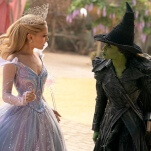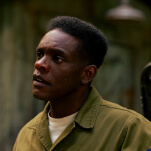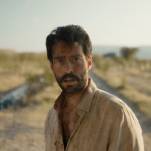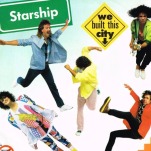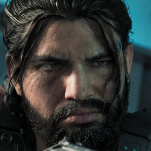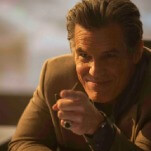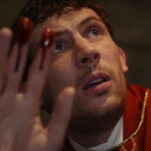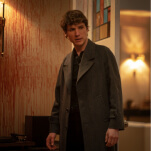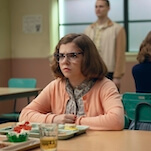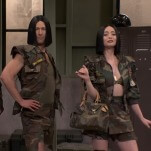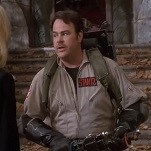Many of the best-loved endings throughout cinema history conform to the notion that endings should be unexpected yet inevitable. The line “Forget it, Jake. It’s Chinatown,” from 1974’s Chinatown, is a culmination of that movie’s deeply cynical worldview—it’s memorable because it encapsulates the entire work in a single pithy offhand remark, but it also seems to come out of nowhere, in the sense that Chinatown hadn’t previously been a significant part of the story. (That film may actually be the record-holder for Longest Delayed Explanation Of Title, not counting movies with titles that never make any sense.) Likewise, when the cabin door closes on John Wayne in the final shot of The Searchers, it hits home because his visual isolation reflects the narrative’s rejection of Ethan’s outmoded value system… but we don’t see it coming, since Ethan himself had betrayed everything he claimed to believe in just a few minutes earlier. Beautifully done.
It’d be a boring world if everything conformed to formula, though, and some of the most enduring finales simply grab you by the scruff of the neck and demand your awe, irrespective of what came before. White Heat is one of very few films I can think of in which the ending is far and away the most iconic moment, to the exclusion of everything else. It’s a superb movie from start to finish, relentlessly gripping, but when you see a clip from it—in an Oscar montage, say—there’s about a 99 percent chance that you’re seeing one particular instant from its last few seconds. Nothing else from White Heat has really made a significant dent in the public consciousness. And yet the ending is actually the least representative part of the movie, to the point where it almost seems to be the ending of a different movie entirely. That’s true even though James Cagney’s famous final line of dialogue repeats a motif that’s recurred for the entire picture. If you need a quick refresher on how it goes down, here’s the last few minutes, starting from the point when Cagney and his last remaining goon head for some massive gas storage tanks, pursued by the coppers.
Obviously, this is a real location, which apparently stood at the exact address noted by the police in the movie: 198th Street and Figueroa in Torrance, California (bordering Los Angeles). You can see that they used rear projection for some of the shots featuring Cagney atop the platform—he’s probably on a set, in footage shot at a separate time than the rest of the scene—but otherwise it appears to be the actual refinery, which was owned by Shell Oil. (Poking around online to see whether this refinery still exists, I learn not only that it doesn’t, but that 198th Street itself seems to have disappeared from Torrance, though you can see where it used to be.) When I first saw White Heat many years ago, I had no idea what those enormous spheres were, though it was clear they were dangerous to shoot at; now I know that gas is stored in spheres (and cylinders) under pressure because you don’t want corners, which are subject to stress fractures. In any event, it’s a wildly photogenic location, the progenitor of any number of action movies in which hero and villain duke it out on a catwalk while dwarfed by machinery.
If this clip is the only part of White Heat that you’ve seen, you’re thinking that Cagney plays a psychotic gangster who spends a lot of time giggling maniacally and referring to himself in the third person. But that’s my point—he doesn’t. We’re told early on that his character, Cody Jarrett, comes from a family with a history of mental illness, and there’s no question that the guy is a sociopath who’s happy to gun down anybody who gets in his way or even slightly inconveniences him. He also suffers from debilitating migraines and has severe mother issues. But he’s not generally a Joker-style wack job, as he appears to be in these last few minutes. When the police turn their spotlights on him and you hear him start chortling under his breath, that’s the first time he’s done so in the entire movie. Previously, he’s been hair-trigger angry in the standard Cagney mode, but also shrewd and self-controlled, except when suffering from a headache or (in the one other contender for a classic scene) grieving at the death of a loved one. His madness appears almost out of nowhere, but because it’s so spectacular, that’s what people remember.
When his confederate, Ryley (Robert Osterloh, who also played the suspicious man who visits Burt Lancaster in that year’s Criss Cross), decides to give himself up, Cagney shoots him dead. No surprise there, as he’s already killed multiple people in the movie. But this is the only time we see him taking sadistic pleasure in killing, with a creepy grin on his face as he takes aim. (He really does look like he could have played a Jack Nicholson-style Joker.) He’d even previously delegated one murder to an underling—that’s how personally uninvested he was. Just business. What we see in this ending, by contrast, is sick glee. After being shot a few times by Edmond O’Brien, and stumbling around laughing some more, Cagney finally blows holes in the tank, sending jets of flame rocketing skyward, and it’s the image of him shouting to the heavens, hellishly lit from behind, that sears itself into your memory forever. In no way has White Heat been building inexorably to this moment—it’s not a movie about a self-destructive lunatic, except insofar as that label applies generally to career criminals—but who cares? Director Raoul Walsh shoots Cagney’s final gesture as a nightmarishly beautiful FUCK YOU to the world. Context is irrelevant.
Not having seen White Heat in ages, I expected the movie to instantly end with the fireball, or at least with O’Brien and the other cops staring in shock at the fireball. As with Psycho, however, it’s easy to forget that there’s a clunky epilogue, though at least it’s mercifully brief in this case. “Cody Jarrett,” sighs one officer, as if he’d anticipated something like this all along. (“Classic Cody.”) And then O’Brien helpfully explains Cagney’s last words for any chimps in the audience: “He finally got to the top of the world, and it blew right up in his face.” Still, Captain Obvious can’t tarnish the grandeur of this otherwise magnificently abrupt finish, even if it’s fun to imagine him showing up at the end of various other movies. (“You’d think he’d give a damn about Scarlett after everything they’ve been through. But he just doesn’t.” “That little alien’s going to be right there. Not literally, though. There in the kid’s heart.”) When you achieve perfection, even it’s only for a few unforgettable seconds, nothing else much matters.








